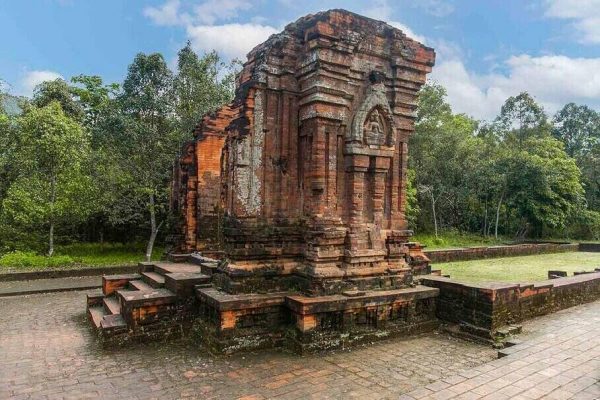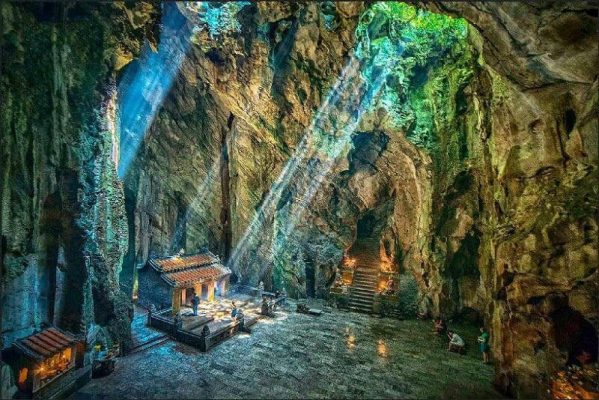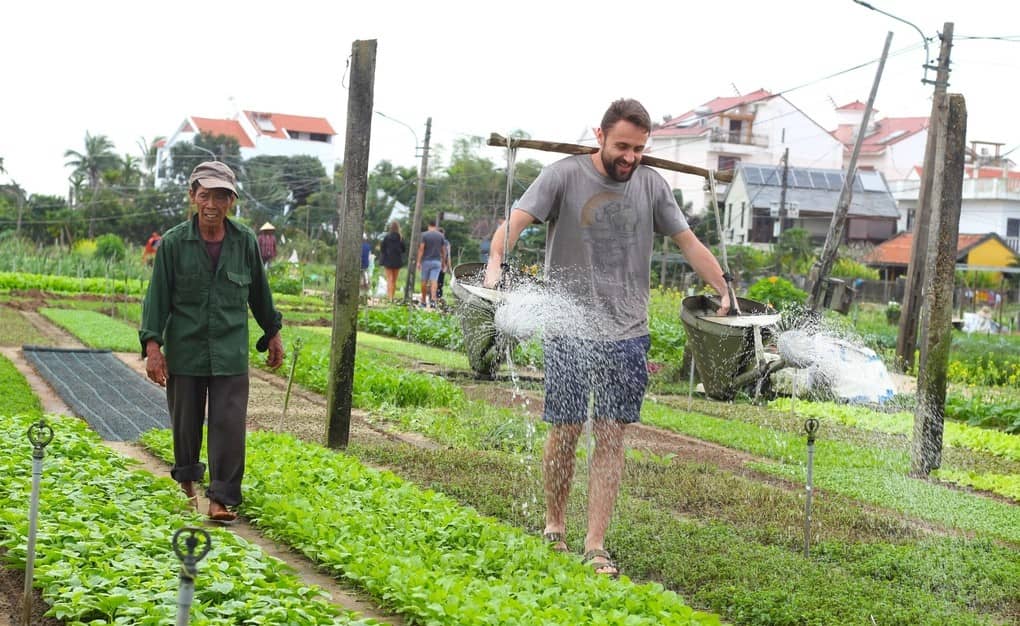
Let’s go back in time with My Son Sanctuary
Explore My Son Sanctuary, a UNESCO World Heritage Site in Vietnam renowned for its ancient Cham temples and stunning architecture. Ula‘s detailed guide provides everything tourists need to know, from historical insights and architectural highlights to practical travel tips, local cuisine, and nearby attractions like Hoi An and Da Nang. Discover the cultural richness and historical significance of My Son Sanctuary and plan your unforgettable visit today.
I. Introduction to My Son Sanctuary
1. What is My Son Sanctuary?
a. Overview of My Son Sanctuary

My Son Sanctuary is a relic of the Cham people
My Son Sanctuary is a cluster of ancient Hindu temples located in the Quang Nam province of central Vietnam. Constructed between the 4th and 14th centuries by the kings of Champa, it served as a religious center dedicated to the worship of the Hindu deity Shiva. Nestled in a lush valley surrounded by mountains, My Son Sanctuary is a testament to the Cham civilization’s sophisticated architecture and spiritual devotion.
b. Historical and Cultural Significance

My Son Sanctuary has great historical and cultural value
My Son Sanctuary is a significant historical site as it offers a glimpse into the spiritual and cultural life of the Cham people, who were influenced by Indian culture and religion. The temples, originally numbering around 70 structures, were built over ten centuries and reflect the evolution of Cham architecture and religious practices.
This site is one of the foremost examples of Hindu architecture in Southeast Asia and has been recognized as a UNESCO World Heritage Site since 1999. The sanctuary not only represents the cultural heritage of Vietnam but also highlights the broader historical connections across Asia.
2. Why Visit My Son Sanctuary?
a. Unique Experience Compared to Other Historical Sites

The monument brings a different experience to visitors
Visiting My Son Sanctuary offers a unique experience distinct from other historical sites in Vietnam due to its rich blend of history, culture, and natural beauty. Unlike the more well-known Angkor Wat in Cambodia, My Son Sanctuary provides a more intimate encounter with ancient ruins nestled in a serene valley. The relatively smaller crowds allow visitors to explore the site at a leisurely pace, absorbing the intricate details of Cham architecture and the mystical ambiance of the surroundings.
b. Appeal to History Buffs, Culture Enthusiasts, and Photographers

Anyone who loves history and architecture will fall in love with My Son Sanctuary
For history buffs, My Son Sanctuary is a treasure trove of ancient artifacts and architectural wonders that tell the story of the Champa Kingdom. Culture enthusiasts will appreciate the site’s deep spiritual roots and its significance in the Hindu tradition, offering insights into the religious practices of a bygone era.
Photographers will find endless opportunities to capture the picturesque ruins framed by lush greenery and dramatic mountain backdrops, making My Son Sanctuary a perfect destination for stunning and evocative photographs.
II. Historical Background of My Son Sanctuary
1. Origins and Construction
My Son Sanctuary was established in the 4th century AD. The oldest structures date back to this period, and the site was continuously developed over the following centuries until the 13th century.

My Son Sanctuary was once the cultural and religious center of the Cham kingdom
The sanctuary was founded by King Bhadravarman of the Champa Kingdom. It was originally constructed as a religious site dedicated to worshiping Hindu deities, primarily Shiva, who was revered under various local names. My Son Sanctuary served as a religious center for the Cham people, functioning as the site for religious ceremonies of the ruling dynasties of Champa as well as a burial place for Cham monarchs and national heroes.
Are you looking for: Da Nang tours
2. Cham Civilization
a. Overview of the Cham People

Cham people
The Cham people are an ethnic group in Southeast Asia, primarily from the central and southern coastal regions of present-day Vietnam. They are descendants of the ancient Champa Kingdom, which was an influential maritime state known for its trade and cultural exchanges with other great civilizations of the time, including India, China, and the Khmer Empire.
b. Cultural and Religious Practices
The Cham civilization was heavily influenced by Indian culture, particularly Hinduism and later Buddhism. Hinduism was the predominant religion, and this influence is evident in the architecture, sculpture, and iconography found at My Son Sanctuary.

My Son Sanctuary was built to worship many Hindu gods
The temples were dedicated to various Hindu gods, and the art typically depicted scenes from Hindu mythology. Religious practices included the worship of deities through rituals and offerings and the construction of temples as acts of devotion. The Cham also practiced ancestor worship and incorporated animistic beliefs into their religious system.
c. UNESCO World Heritage Site
My Son Sanctuary was designated a UNESCO World Heritage Site in 1999. This designation was granted in recognition of its cultural significance and the remarkable state of preservation of the Cham monuments.

This place is one of eight UNESCO World Heritage Sites in Vietnam
The designation of My Son Sanctuary as a UNESCO World Heritage Site underscores its global importance as a cultural and historical treasure. It recognizes the sanctuary’s outstanding value as a testament to the Cham civilization’s architectural, cultural, and religious achievements. The implications of this status are significant:
- Preservation Efforts: The UNESCO designation has spurred increased efforts to preserve and restore the site, involving both local and international expertise.
- Tourism Boost: Recognition by UNESCO has attracted more global tourists, bringing attention to Vietnam’s rich cultural heritage and promoting sustainable tourism.
- Cultural Exchange and Awareness: The site’s status fosters greater understanding and appreciation of the Cham culture and history among visitors worldwide.
- Funding and Support: The UNESCO label often attracts funding and support from various governments and organizations dedicated to cultural preservation.
Do not miss: Da Nang to Hue – Unexpected Trip You’ll Love
III. Architectural Highlights of My Son Sanctuary
1. Structure and Design
My Son Sanctuary is a complex of Hindu temples that were constructed between the 4th and 14th centuries by the Champa civilization. The sanctuary comprises over 70 structures, including temples, towers, and other religious buildings, though many have been reduced to ruins over time. The temples are grouped into clusters, each named after a letter of the alphabet (e.g., Group A, Group B, etc.).

My Son Sanctuary is a complex of Hindu temples
Each cluster typically contains a principal sanctuary (kalan), surrounded by secondary buildings such as libraries (kho) and meditation halls. The sanctuaries are constructed of red brick, with intricate carvings and sculptures adorning the surfaces. The temples were built without the use of mortar; instead, the bricks were meticulously cut and fitted together, a technique that has intrigued archaeologists and historians.
Start your journey with: Da Nang to Hoi An in 4 Days
2. Architectural Styles and Influences
The architecture of My Son Sanctuary shows significant Indian influence, reflecting the religious and cultural exchanges between the Cham people and Indian civilization. This influence is evident in the use of the Bhadreshvara temple style, characterized by tall, slender towers with elaborate spires, reminiscent of South Indian temple architecture.

The architecture of My Son Sanctuary is greatly influenced by Indian
The temples also exhibit distinct Cham architectural styles, such as the utilization of sandstone for intricate carvings and the incorporation of local iconography. The structures are designed to align with the principles of Hindu cosmology, symbolizing Mount Meru, the center of the universe in Hindu and Buddhist cosmology. The principal deity worshipped at My Son Sanctuary is Shiva, represented in the form of a linga (an abstract representation of the god).
You will be like: Discover Central Vietnam Tour in 6 Days
3. Iconography and Art
Detailed Descriptions of Sculptures and Carvings
The sculptures and carvings at My Son Sanctuary are remarkable for their artistic detail and religious significance. The walls of the temples are adorned with bas-reliefs depicting various Hindu deities, mythological scenes, and sacred animals. Notable carvings include depictions of Shiva in various forms, as well as figures of gods such as Vishnu and Brahma.

The walls are carved with Hindu deities
One of the most significant aspects of Cham art is the depiction of apsaras (celestial dancers) and dvarapalas (guardian figures), which are commonly found at the entrances of the temples. These figures are characterized by their elegant poses and intricate jewelry, reflecting the high level of craftsmanship achieved by Cham artisans.
Symbolism in Cham Art
Cham art is rich in symbolism, often reflecting Hindu religious concepts and local beliefs. The use of the linga and yoni (representations of Shiva and Shakti) is prevalent, symbolizing creation and fertility. The carvings of sacred animals, such as the Nandi bull (the mount of Shiva) and garudas (mythical bird-like creatures), are also significant, representing strength and divine protection.

Symbolism in Cham Art
The intricate floral and geometric patterns that adorn the temples are not merely decorative but carry symbolic meanings, representing the divine order and harmony of the universe. The repeated use of lotus motifs, for example, symbolizes purity and enlightenment.
More details: Central Vietnam Wonders Tour
IV. Exploring My Son Sanctuary
My Son Sanctuary offers a plethora of activities that provide an immersive experience of the ancient Champa civilization and the natural beauty surrounding the site. Here are some of the most captivating activities:
1. Visiting the Cham Towers

Cham Towers
The main attraction at My Son Sanctuary is the collection of ancient Cham towers. These architectural marvels, built between the 4th and 14th centuries, showcase the intricate craftsmanship and religious significance of the Champa civilization.
Highlights: Each tower is unique, with detailed carvings and sculptures depicting Hindu deities, mythical creatures, and religious symbols.
Click here: Central Vietnam Wonders Tour
2. Learning about Cham culture

Traditional dance of the Cham ethnic group
Cultural Insights: Engage with the rich history and culture of the Cham people through guided tours and museum exhibits. Learn about their religious practices, daily lives, and the historical context of My Son.
Cultural Performances: Witness traditional Cham music and dance performances that bring the ancient rituals and stories to life.
3. Trekking in the Primary Forest
Nature Walks: Surrounding My Son Sanctuary is a lush, primary forest that offers excellent trekking opportunities. Trails vary in difficulty, making them suitable for both casual walkers and avid hikers.
Flora and Fauna: Discover a variety of native plant species and potentially spot local wildlife. The forest provides a serene backdrop to the ancient ruins.
4. Participating in Traditional Festivals

Cham festivals
Festivals: Throughout the year, My Son Sanctuary hosts traditional Cham festivals. These events are a great way to experience the vibrant culture, including traditional music, dance, and ceremonies.
Special Events: Plan your visit around major festivals for a unique and enriching experience.
V. Travel Tips for Visitors
1. Best Time to Visit My Son Sanctuary
- Season: The ideal time to visit is from February to April and August to October, when the weather is cooler and more pleasant.
- Time of Day: Early mornings are recommended to avoid crowds and the midday heat.
2. Visitor Information
Opening Hours
- Daily from 6:00 a.m. to 5:00 p.m.
- Note: Hours may vary on holidays, so check ahead if visiting during a holiday period.
Ticket Prices
- Adults: approximately 150,000 VND (about $6.50 USD).
- Children under 15: free entry.
VI. Nearby Attractions
1. Hoi An Ancient Town

Hoi An Ancient Town
Distance from My Son Sanctuary
- Hoi An is approximately 40 kilometers (about 25 miles) from My Son Sanctuary. The drive takes around 1 to 1.5 hours, depending on traffic.
Highlights of Hoi An
- Historic Architecture: Hoi An is known for its well-preserved ancient town, featuring a mix of different architectural styles, including Vietnamese, Chinese, Japanese, and French influences. Notable structures include the Japanese Covered Bridge and the Phung Hung Old House.
- Lantern Festival: On the 14th day of each lunar month, Hoi An transforms during the Lantern Festival, with colorful lanterns lighting up the streets, traditional music, and performances.
- Tailor Shops: Hoi An is famous for its custom tailoring. Visitors can have bespoke clothing made quickly and affordably.
- Cuisine: The town offers a variety of local dishes such as Cao Lau, White Rose Dumplings, and Hoi An Chicken Rice. Culinary classes are also popular among tourists.
- Riverside Market: The bustling market along the Thu Bon River is an excellent place to experience local life, buy souvenirs, and enjoy street food.
Learn more about: Hoi An Ancient Town
2. Major Attractions in Da Nang

Cham Museum
- Dragon Bridge: A unique bridge that breathes fire and water on weekends and holidays, offering a spectacular night-time display.
- Ba Na Hills: Home to the famous Golden Bridge held up by giant stone hands, this mountain resort complex offers panoramic views, gardens, and an amusement park.
- Cham Museum: The Da Nang Museum of Cham Sculpture houses the world’s largest collection of Cham artifacts, providing deeper insight into the Cham culture and history linked to My Son Sanctuary.
Beaches, Museums, and Other Points of Interest
- My Khe Beach: Often cited as one of the most beautiful beaches in the world, My Khe offers white sand, clear water, and a variety of water sports.
- Son Tra Peninsula: Known as Monkey Mountain, this nature reserve is ideal for hiking, spotting wildlife, and visiting the Linh Ung Pagoda with its towering Lady Buddha statue.
- Han Market: A vibrant market where visitors can purchase everything from local produce to souvenirs and clothing.
- Da Nang Cathedral: A pink-painted Gothic-style church built during the French colonial period, also known as the Rooster Church due to the weathercock on its steeple.
3. Natural Landscapes
Marble Mountains

Marble Mountains
Overview: A cluster of five marble and limestone hills named after the five elements (metal, wood, water, fire, and earth), the Marble Mountains offer a mix of natural beauty and spiritual significance.
Activities: Visitors can explore caves, tunnels, and Buddhist sanctuaries. Thuy Son Mountain is the most popular, with its panoramic view from the summit after climbing a series of steps.
Cultural Sites: Within the mountains are several pagodas and grottoes, such as the Huyen Khong Cave, which is adorned with Buddhist statues and carvings.
Learn more about: Marble Mountains
Bach Ma National Park

Bach Ma National Park
Location and Access: About 90 kilometers (55 miles) from Da Nang, Bach Ma National Park can be reached in around 2 hours by car.
Biodiversity: The park is known for its rich biodiversity, hosting over 1,400 species of plants and numerous animals, including gibbons, langurs, and several bird species.
Activities: Popular activities include trekking through lush forests, visiting waterfalls like Do Quyen Waterfall, and enjoying panoramic views from the summit of Bach Ma Mountain.
Accommodation: There are several eco-lodges and campsites within the park for those who wish to stay overnight and immerse themselves in nature.
In summary, My Son Sanctuary stands as a testament to the rich cultural and historical heritage of Vietnam, offering visitors a unique glimpse into the ancient Cham civilization. Its breathtaking architecture, intricate sculptures, and serene environment make it a must-visit destination for travelers seeking an immersive cultural experience. Whether you’re a history enthusiast, a photography lover, or simply someone looking to explore Vietnam’s diverse attractions, My Son Sanctuary promises an unforgettable journey back in time. Don’t miss the chance to witness this UNESCO World Heritage Site and uncover the stories etched in its ancient stones. Plan your visit today and embark on a captivating adventure through one of Vietnam’s most treasured landmarks.
See more: Da Nang travel tips



























